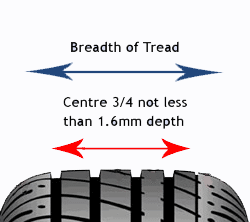 |
The law of the country is that the tread depth must not be under the legal limit of 1.6mm. The full extent of the 1.6mm rule is explained below: The grooves of the tread must not be lower than 1.6mm through out a continuous band and must be ¾ of the breadth and entire outer circumference of the tyre. The tyres on the car must also be correctly matched, so they should be the correct type, correct size, correct structure and they should be on the correct axle of the vehicle |
|
 |
How to check tread depth Most tyres now also have a depth indicator as shown in the picture above. The depth indicator is placed around the tyre within the groove. This is an easy way to check your tread depth. Once this groove indicator levels off with the top the tread the tyres are at 1.6mm. Our advice is that you should change your tyres at 2mm and don’t risk getting penalty points or a fine. More importantly the more a tyre wears the less it is able to function in the wet. The importance of changing your tyres early was highlighted recently by Continental and tests carried out by Auto express. demonstrated that a tyre with 3mm tread reaming had nearly a quarter less of the stopping distance of a tyre at 1.6mm whilst travelling at 50mph. This could be the difference between hitting an obstacle or even saving a life. The tread depth groove in the tyres will tell you when your tyres are at the bare legal minimum of 1.6mm, ideally you should change your tyres earlier. The best way to check you tread depth is to buy a tread depth gauge. The gauge will give you the exact amount of tread remaining and will a lot more accurate. The tread depth gauge comes in various forms. The most accurate is the digital type however the analogue type are just as good. |
||